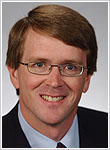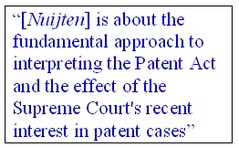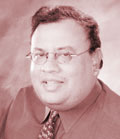Tag Archives: obviousness
Impact of KSR v. Teleflex on Pharmaceutical Industry
For the past 30 years, Cal has been a litigation analyst serving the investment community. He is member of the New York Bar and a graduate of Northwestern law School. www.litigationnotes.com.
=====================
By Cal Crary:
We do not believe that too much guessing is needed to see what the new patent environment will be like, since we already have the benefit of Chief Judge Michel’s March 23, 2007 decision in the Norvasc case, in which he identified the likely changes in the court’s obviousness jurisprudence. . . . A few of the principles reflected in Judge Michel’s opinion are as follows:
- routine testing to optimize a single parameter, rather than numerous parameters, is obvious;
- an approach that is obvious to try is also obvious where normal trial and error procedures will lead to the result;
- unexpected results cannot overcome an obviousness challenge unless the patentee proves what results would have been expected;
- a reasonable expectation of success does not have to be a predictable certainty but rather it can be an expectation that can be satisfied by routine experimentation; and
- motivation can be found in common knowledge, the prior art as a whole or the nature of the problem itself.
....
[T]here are certain types of patents in the pharmaceutical industry that will have to be looked at, or looked at again, in light of the Supreme Court’s opinion. We happen to believe that enantiomer patents are especially vulnerable, at least in cases in which the technology to separate them was available in the public domain at the time the separation was made. However, we do not believe that the courts will permit a massive extermination of drug industry patents or that a meat-axe approach to them will be used. Rather, we think the Supreme Court’s only demand is that common sense be injected into the determination of what a person of ordinary creative skill in the art would do. The primary examples of enantiomer patents that we regard as vulnerable include Forest Labs’ Lexapro, Bristol-Myers’ Plavix, AstraZeneca’s Nexium and Johnson & Johnson’s Levaquin. We think that all four of these drugs are especially vulnerable now, in light of the new, broader scope of obviousness. In the case of Levaquin, Mylan Labs lost at the district court level in a case that it should have won, even under the law as it existed at the time, and then it was affirmed by Judge Pauline Newman, a pro-industry Federal Circuit judge, in a non-precedential decision without opinion. In a new case, if obviousness is in the mix and if Judge Newman is avoided on appeal, then Levaquin will be a generic drug.
To continue reading, become a Patently-O member. Already a member? Simply log in to access the full post.
KSR and the F-Words
Now that the Supreme Court has issued its opinion in KSR v. Teleflex, the first reaction is what took it so long? During the past six months since oral arguments in late November, I was expecting that the Court was taking its time crafting a historical opinion that delved into the genesis and evolution of the nonobviousness doctrine since the Hotchkiss decision in 1851. The Court does mention the Hotchkiss decision and a few others, but the six month gestation has yielded a compact, thirty page decision that can be summarized with three simple F-words: formalism, functionality, and flexibility.
To continue reading, become a Patently-O member. Already a member? Simply log in to access the full post.
KSR v. Teleflex: A Tale Full of Sound and Fury, Signifying Little?
By Professor Gregory Mandel
Though the Supreme Court’s unanimous reversal in KSR v. Teleflex, No. 04-1350, 550 U.S. ___ (2007), contains some harsh words for the Federal Circuit’s teaching, suggestion, or motivation (TSM) test, the decision itself appears to leave the TSM requirement roughly intact. Justice Kennedy’s opinion emphatically rejects an 'explicit' TSM test—one that would require explicit prior art teachings in order to combine given references in the obviousness analysis. At the same time, the decision appears to essentially recreate the 'implicit' or 'flexible' TSM test—one that would allow implicit suggestions, such as the nature of the problem, to provide the requisite motivation to combine. It is this implicit TSM requirement that represented current Federal Circuit doctrine, pursuant to several decisions published after certiorari was granted in KSR (e.g., In re Kahn, DyStar, & Alza). In fact, the Supreme Court even indicates that the Federal Circuit may have gotten it right in these post-cert cases. The KSR opinion is more a critique of the Circuit's application of the obviousness (and TSM) standard to the specific facts in 
Under KSR, in order to evaluate whether a given combination was obvious, the factfinder must "determine whether there was an apparent reason to combine the known elements in the fashion claimed by the patent at issue." The Supreme Court’s "reason to combine" sounds significantly like "suggestion, teaching, or motivation to combine." It is interesting that the Court used a term as loose as “reason,” given concerns raised during oral argument about the indefiniteness of the term “motivation.” In addition, the Court requires that, "[t]o facilitate review, the analysis should be made explicit," a proposition for which the Court cites Kahn, warning that conclusory statements are not sufficient. The Court goes on to criticize rigid application of TSM, particularly relying solely on published articles and explicit content of issued patents. But, the Court notes, "In the years since the Court of Customs and Patent Appeals set forth the essence of the TSM test, the Court of Appeals no doubt has applied the test in accord with these principles in many cases. There is no necessary inconsistency between the idea underlying the TSM test and the Graham analysis." And, the Court explicitly notes that the post-cert Circuit cases were not before it: "The extent to which [DyStar and Alza] may describe an analysis more consistent with our earlier precedents and our decision here is a matter for the Court of Appeals to consider in its future cases." The opinion also clearly (appropriately in my opinion) invites greater analysis of the PHOSITA and the circumstances surrounding the PHOSITA and the pertinent technology than the Circuit has engaged in in some of its decisions.
To continue reading, become a Patently-O member. Already a member? Simply log in to access the full post.
Sarnoff Discusses KSR v. Teleflex
By Professor Joshua Sarnoff, Assistant Director of the Glushko-Samuelson Intellectual Property Law Clinic and a Practitioner-in-Residence at the Washington College of Law, American University. Professor Sarnoff filed an amicus brief in support of Petitioner KSR.
In its unanimous decision in KSR Int’l. Co v. Teleflex Inc., No. 04-1350 (April 30, 2007), the Supreme Court expressly overruled the Court of Appeals for the Federal Circuit’s “teaching-suggestion-motivation” (“TSM”) test for finding a claimed invention obvious and reaffirmed the Court’s precedents (in light of the 1952 enactment of Section 103 and its holding in Graham v. John Deere Co. of Kansas City, 383 U.S. 1 (1966)) regarding the obviousness of patents “based on the combination of elements found in the prior art” where there the combination “does no more than yield predictable results.” Slip op. at 11-12. The Court’s decision has therefore called into question the validity of hundreds of thousands of claims in issued patents, and will likely lead to a dramatic change to the method by which the Patent Office, the courts, and the bar conduct their obviousness analyses.
Nevertheless, the Supreme Court’s opinion appears self-consciously narrow and provides little additional guidance for how to apply the Graham approach. The Court’s decision leaves unclear whether the party with the burden of proving obviousness must demonstrate that “there was an apparent reason to combine the known elements in the fashion claimed by the patent at issue,” or only that the claim at issue if patented would reflect an “advance[] that would occur in the ordinary course without real innovation[, which] retards progress and may, in the case of patents combining previously known elements, deprive inventions of their value or utility.” Slip op. at 14, 15. As the Court noted, “as progress beginning from higher levels of achievement is expected in the normal course, the results of ordinary innovation are not the subject of exclusive rights under the patent laws. Were it otherwise patents might stifle, rather than promote, the progress of useful arts.” Slip op. at 24. Although the Court recited the Constitutional language, it did not expressly hold that obviousness is a constitutional requirement. Further, the Court left to later case law any consideration of the extent to which the Court of Appeals’ more recent statements regarding the flexibility of its TSM test is consistent with Graham and the Supreme Court’s earlier precedents. Slip op. at 18.
To continue reading, become a Patently-O member. Already a member? Simply log in to access the full post.
Wegner on Patent Reform
To continue reading, become a Patently-O member. Already a member? Simply log in to access the full post.
CAFC Stays Permanent Injunction against Vonage Pending Appeal
To continue reading, become a Patently-O member. Already a member? Simply log in to access the full post.
Omeprazole Manufacturing Patent: 2-1 Inherent Anticipation
To continue reading, become a Patently-O member. Already a member? Simply log in to access the full post.
Patent Exhaustion at the Supreme Court
To continue reading, become a Patently-O member. Already a member? Simply log in to access the full post.
PTO: Second Pair of Eyes and Quality Review
To continue reading, become a Patently-O member. Already a member? Simply log in to access the full post.
Routine Experimentation -> Obvious
To continue reading, become a Patently-O member. Already a member? Simply log in to access the full post.
Community Review: Volunteers?
To continue reading, become a Patently-O member. Already a member? Simply log in to access the full post.
Cargill v. Canbra: Extensive Prosecution Increases Likelihood of Inequitable Conduct
To continue reading, become a Patently-O member. Already a member? Simply log in to access the full post.
Claim Transitions: "Comprising The Steps Of"
To continue reading, become a Patently-O member. Already a member? Simply log in to access the full post.
Signals Per Se; Nuijten; Textualism; and Floodgates
To continue reading, become a Patently-O member. Already a member? Simply log in to access the full post.
Peer-to-Patent Expected To Launch in April 2007
To continue reading, become a Patently-O member. Already a member? Simply log in to access the full post.
In re Nuijten: Patentable Subject Matter, Textualism and the Supreme Court

[PDF Version of this Post] In re Nuijten, which is being argued to the Federal Circuit today, presents the important issue of whether a new type of artificially constructed signal may be patented. The Patent and Trademark Office opposes patentability on the grounds that, as a matter of textual interpretation, signals do not fall within any one of the four categories of patentable subject matter - "process, machine, manufacture, or composition of matter" - identified in section 101 of the Patent Act. PTO Br. at 12 (quoting 35 U.S.C. § 101). Though Nuijten raises important issues concerning the scope of patentable subject matter under U.S. law (and that's reason enough for most patent practitioners and scholars to care about its outcome), the case is also about much more. It is about the fundamental approach to interpreting the Patent Act and the effect of the Supreme Court's recent interest in patent cases. To appreciate those larger issues, we must begin with a basic understanding of the facts at issue.

To continue reading, become a Patently-O member. Already a member? Simply log in to access the full post.
Zyprexa Patent Upheld on Appeal
To continue reading, become a Patently-O member. Already a member? Simply log in to access the full post.
In Preliminary Injunction Decision, CAFC Forecasts Post-eBay Jurisprudence
To continue reading, become a Patently-O member. Already a member? Simply log in to access the full post.
Obviousness: Skill in the Art Avoids Death Ray
To continue reading, become a Patently-O member. Already a member? Simply log in to access the full post.

 By Professor
By Professor 